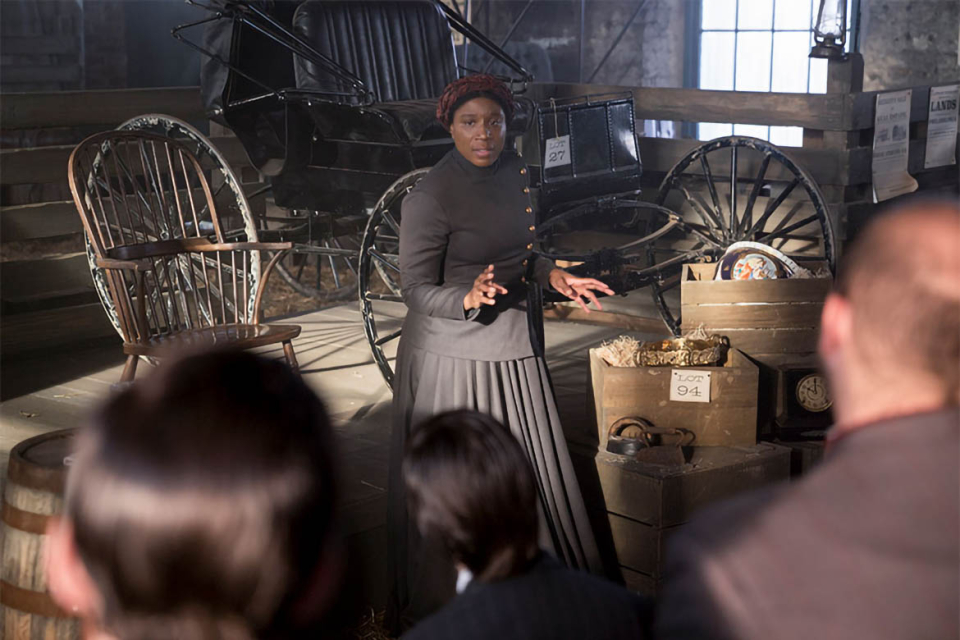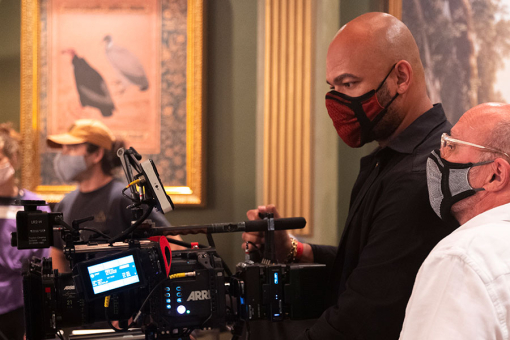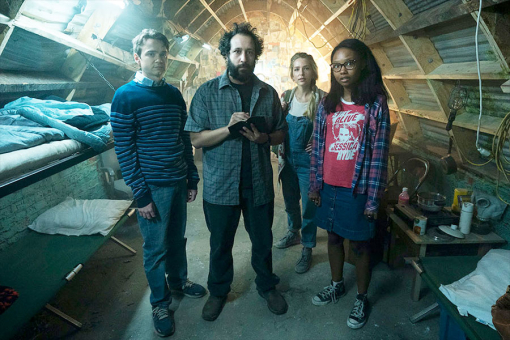If a television show breaks from its standard format for a special episode, it usually waits a few seasons into its run.
Underground, the WGN series focusing on the Underground Railroad and abolitionists, wasted no time in taking a sideways step from the norm to introduce one of the most important figures in American history, Harriet Tubman, in the sixth episode of their sophomore season.
“Minty,” written by Misha Green and Joe Pokaski, introduces Harriet Tubman (Aisha Hinds) to Underground viewers and its cast, as she addresses a group of abolitionists to relay her life’s story and inspire them to action. Unlike the rest of the series, “Minty” confines itself to a single set – an auction house.
For the episode, Underground discarded its trappings of quick edits, contemporary music, core characters, and multiple storylines to focus all its attention into introducing a historical giant. “Minty” manages to avoid coming off as filmed a stilted stage play, while done in the contemporary style of a “TED talk.”
The limitations set forth by this episode were a welcomed challenge for its director, Anthony Hemingway. Hemingway’s past directing endeavors include The Wire, True Blood, and American Crime Story, making him a wise choice to helm such a landmark episode. “This has been one of the most exhilarating, exciting opportunities I’ve had as an artist,” shared Hemingway. “I feel this is episode is the boldest we’ve done.”
How did the decision to break format for this episode come about?
We have amazing new thinkers and risk takers as creatives of the show.
I remember before the second season started, the [writing staff] started breaking down stories for me, and seeing how our season would look. When they came to me about “Minty,” I keep expecting them to tell me, “Okay, we’re kidding [about doing this]. It’s going to be an episode about Harriet Tubman and it’s just her talking throughout the episode.”
And I thought, “Okay, that’s amazing, but what else is going to happen?” It was revealed that this was what was necessary for this moment, for honoring, reintroducing, and for giving the stage to the legacy of Harriet Tubman’s humanity. It needed this platform. It was an episode that was so exciting, nerve-wracking, and scary to approach.
Let’s discuss those initial impressions. At this stage in production, you only have a few episodes under your belt. Was there any hesitation to do this kind of show?
I fall in line with being the type of filmmaker and artist that isn’t afraid to enter this arena. I championed it from the beginning. I got super excited about it.
The credit obviously goes to Harriet Tubman for being the amazing woman she is known and we remember her to be. And you will learn more about her than you’ve ever learned about her in this episode. Joe and Misha get the credit for that, and I’m so excited to be a part of it.
One of the most common questions people making a series typically ask themselves after the success of the first season is how to top that success. Are you going to elevate it and continue raising the bar and aiming really high?
From the outset of Underground, we wanted to be bold. We wanted the show to be different and defy any expectations of the show’s time period, the narrative, and what people think they were coming to experience. We wanted to shake up the viewer, and to really use this episode as an awesome experience of reinvigorating the understanding and knowledge of truth, strength, and inspiration.
How did you avoid turning this into a “very special episode” or making this episode look like a stage production?
When you speak of someone as deserving to be honored and given the floor and time to actually reveal who Harriet Tubman is, I think one hour can barely do that. I’m of the mind as a filmmaker and artist to change the game of where we are.
Coming to episode six, we learned in the research for this season, was that Harriet Tubman would put her life on the line for her cause of helping to inspire people by doing public speaking. For us it was figuring out what our present commonality was, how can we connect this to today?
Joe and Misha said this our “TED Talk” in the 1850s. It was that thing of trying to wrap your head around the setting for this and how we were going to do it. She obviously was under the laser eye of being sought after, so it couldn’t be too public. It had to be a private event. It was one of those natural things for me as a director to ask, “Okay, how will I approach this?”
How did you approach it?
This is one person talking the entire episode. Do I have to give it any kind of glamor or make it visually exciting? Do I have to come in with swooping cameras, come up through the floor, through the ceilings, or the windows? It’s like, “My God, what am I going to do to keep people’s interest?”
At a certain point, I had to realize I was thinking too much and had to surrender to my own faculties. It was figuring out that the star was really Harriet Tubman and not doing anything to distract from that or upstage her. All I really want to do is give it a heartbeat of empathy and understanding of being with her. And, to make choices that really punctuate what she’s saying, what she’s feeling, or what’s she sharing.
It’s pure humanity that she’s able to explore in this episode, and I can’t remember in my lifetime of learning and researching Black History that I’ve ever experienced an understanding of this woman that we experience in “Minty.” It’s so encouraging for me and exciting to honor my heritage, culture, and history, and to honor Harriet Tubman
It’s an interesting choice to set the in an auction house. Was that intentional?
It was not intentional, to be honest. It was a thinking of where we are [during the series]. Technically, she’s in a free state. She’s talking a group of abolitionists that all have their own lives, personalities, jobs, connections, and resources.
Then, you have to think about the psychology of someone in here that has to support this opportunity for Harriet Tubman to be able to come into a space and talk. We thought about churches. We looked at different ideas of what really had the best feeling.
For me, I wanted the priority for wherever we landed to be visual. I didn’t want to be in a spot where it had no visual interest and didn’t show expression of the time during the time she’s speaking. It wasn’t just five minutes, she really takes time to sit there and share her life and her story so you want to feel the progression of the day. We get to do that with light.
At the same time, having windows and the connection of having a real world connected here gives a feeling that she was vulnerable here. You wanted to have the opportunity and visuals to see that. At any time, someone could have busted in there and caused a problem.
What was it like directing someone playing someone who means so much to you, yet that you never could have met? Did you wonder if you have the right to do it? How did you approach it?
It’s really from a place of reverence. I approach anything that I’m doing from a place of honesty, truth, and understanding, with a degree of sensitivity and empathy to whatever I’m doing or exploring.
For this opportunity, it was really honoring Harriet Tubman. Even with what I’m reading, what we researched, and what I learned about her to realize that she wasn’t just a character or a caricature, she was a human being. So, there are so many elements from a human place that I myself relate to, and hoping that people who will come to watch this, will see themselves in her as well.
She shared her life; she was a giver. I was able to tap into that and understand and allow myself to be the vessel to help channel it and get it on the screen. I had to realize I just really had to surrender and just kind of roll with how I reacted to every moment. I obviously had a plan and ideas from the beginning on what I wanted to highlight and what angles I wanted to use for certain moments.
It’s my style to listen and deviate as necessary. It happened when we started [filming] and Aisha got lost in the spirit of playing Harriet. I was weeping watching her performance. The other thing was realizing where we wanted all the beats and nuances to land, and I didn’t want to do anything to detract from that. I was moved and I was [present] in it, not just from a place of being there as a technician or the filmmaker to help tell the story.
Three days to film an entire episode is remarkable.
What Aisha did and embodied in the performance of this episode is amazing. She literally gave a one-woman show. I tweeted and Instagramed about it while we were shooting. Our first day was 18 pages of dialogue, basically. She had a week with the script and got out there and allowed herself to be used. It spoke through her and was something to be watched.
Has this episode changed how you approached the remainder of season two and how you might shoot season three?
For me, no. Episode six was the last thing we shot. It was the last three days. That’s the other thing that was ridiculously phenomenal. We shot it in three days not because we wanted to, but because we had to because of logistical circumstances.
Was this episode the most difficult project you’ve directed?
On television, yes. Underground is the hardest thing that I’ve directed. This show has totally has bent me, it has broken me, it has stretched me, and ultimately, all that has elevated me. I am so proud of what we are doing, the story we’re telling, and these opportunities.
It really has, one hundred percent, taken and required blood, sweat, and tears in making this show happen. I’m very happy and proud.
Underground airs on WGN on Wednesdays at 10pm.














